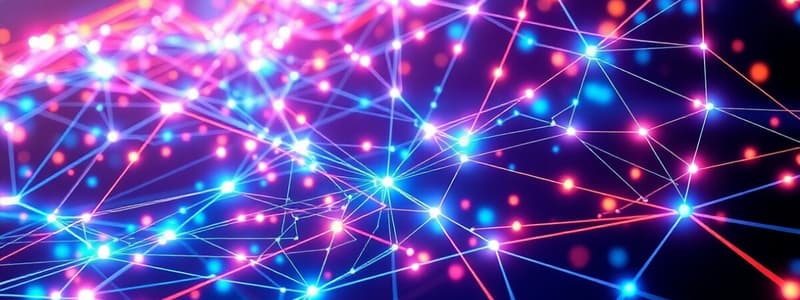Podcast
Questions and Answers
What is a network?
What is a network?
- A software program for managing files
- A single computer used for data processing
- A storage device for backing up data
- A collection of interconnected devices for communication and resource sharing (correct)
Which network type covers a small area such as a home or office?
Which network type covers a small area such as a home or office?
- Local Area Network (LAN) (correct)
- Metropolitan Area Network (MAN)
- Wide Area Network (WAN)
- Personal Area Network (PAN)
Which topology has all devices connected to a central cable?
Which topology has all devices connected to a central cable?
- Ring topology
- Star topology
- Mesh topology
- Bus topology (correct)
In a star topology, what is the central connecting device?
In a star topology, what is the central connecting device?
Which network device forwards data based on IP addresses?
Which network device forwards data based on IP addresses?
What does WAP stand for?
What does WAP stand for?
Which protocol is used for transmitting web pages over the internet?
Which protocol is used for transmitting web pages over the internet?
What is the purpose of DNS?
What is the purpose of DNS?
Which IP address version uses 128-bit addresses?
Which IP address version uses 128-bit addresses?
What is a MAC address?
What is a MAC address?
Which layer of the OSI model is closest to the end user?
Which layer of the OSI model is closest to the end user?
What is the main purpose of a firewall?
What is the main purpose of a firewall?
Which wireless technology is commonly used for short-range connections like headphones?
Which wireless technology is commonly used for short-range connections like headphones?
Which cellular technology is considered the latest generation, offering faster speeds and lower latency?
Which cellular technology is considered the latest generation, offering faster speeds and lower latency?
What is bandwidth?
What is bandwidth?
What is latency?
What is latency?
What is throughput?
What is throughput?
What is Internet of Things (IoT)?
What is Internet of Things (IoT)?
What does edge computing involve?
What does edge computing involve?
Flashcards
What is a network?
What is a network?
Interconnected devices that communicate and share resources.
Personal Area Network (PAN)
Personal Area Network (PAN)
Connects devices within an individual's immediate range, like with Bluetooth.
Local Area Network (LAN)
Local Area Network (LAN)
Connects devices in a limited area like a home, school, or office.
Wireless Local Area Network (WLAN)
Wireless Local Area Network (WLAN)
Signup and view all the flashcards
Metropolitan Area Network (MAN)
Metropolitan Area Network (MAN)
Signup and view all the flashcards
Wide Area Network (WAN)
Wide Area Network (WAN)
Signup and view all the flashcards
Bus Topology
Bus Topology
Signup and view all the flashcards
Star Topology
Star Topology
Signup and view all the flashcards
Ring Topology
Ring Topology
Signup and view all the flashcards
Mesh Topology
Mesh Topology
Signup and view all the flashcards
What does a network hub do?
What does a network hub do?
Signup and view all the flashcards
What does a network switch do?
What does a network switch do?
Signup and view all the flashcards
What does a router do?
What does a router do?
Signup and view all the flashcards
Domain Name System (DNS)
Domain Name System (DNS)
Signup and view all the flashcards
Dynamic Host Configuration Protocol (DHCP)
Dynamic Host Configuration Protocol (DHCP)
Signup and view all the flashcards
IP Address
IP Address
Signup and view all the flashcards
OSI Model
OSI Model
Signup and view all the flashcards
Access Control Lists (ACL)
Access Control Lists (ACL)
Signup and view all the flashcards
Wi-Fi (Wireless Fidelity)
Wi-Fi (Wireless Fidelity)
Signup and view all the flashcards
Bandwidth
Bandwidth
Signup and view all the flashcards
Study Notes
- A network is a collection of interconnected devices, enabling communication and resource sharing
Network Types
- Personal Area Network (PAN): Connects devices within an individual's immediate range, typically using technologies like Bluetooth
- Local Area Network (LAN): Connects devices within a limited area such as a home, school, or office
- Wireless Local Area Network (WLAN): A LAN that uses wireless communication.
- Metropolitan Area Network (MAN): Covers a larger area than a LAN, such as a city
- Wide Area Network (WAN): Spans a large geographical area, such as a country or the globe, connecting multiple LANs and MANs
Network Topologies
- Bus topology: All devices are connected to a central cable, called the bus
- Simple but a break in the bus cable can disrupt the entire network
- Star topology: All devices connect to a central hub or switch
- A failure in one device does not affect the rest of the network, but failure of the central hub can bring down the entire network
- Ring topology: Each device is connected to two other devices, forming a ring
- Data travels in one direction, and a break in the ring can disrupt the network
- Mesh topology: Each device is connected to many other devices
- Highly redundant, but complex and expensive to implement
- Tree topology: Combines characteristics of linear bus and star topologies; groups of star-configured networks are connected to a linear bus backbone
Network Devices
- Hub: A simple device that connects multiple devices in a LAN, forwarding all received data to all connected ports
- Switch: An intelligent device that forwards data only to the intended recipient based on MAC addresses
- Router: Connects different networks, forwarding data based on IP addresses
- Modem: Modulates and demodulates signals to transmit data over telephone lines or other communication channels
- Wireless Access Point (WAP): Allows devices to connect to a network wirelessly, typically a Wi-Fi network
- Firewall: A security device that monitors and controls network traffic, blocking unauthorized access while permitting legitimate communications
- Bridge: Connects two LANs together, forwarding traffic based on MAC addresses
Communication Protocols
- TCP/IP (Transmission Control Protocol/Internet Protocol): A suite of protocols that governs communication over the Internet, including IP addressing, routing, and data transmission
- HTTP (Hypertext Transfer Protocol): Used for transmitting web pages and other content over the Internet
- HTTPS (HTTP Secure): A secure version of HTTP that uses encryption to protect data in transit
- FTP (File Transfer Protocol): Used for transferring files between computers on a network
- SMTP (Simple Mail Transfer Protocol): Used for sending email messages
- DNS (Domain Name System): Translates domain names into IP addresses
- DHCP (Dynamic Host Configuration Protocol): Automatically assigns IP addresses to devices on a network
- SSH (Secure Shell): Provides a secure, encrypted connection to a remote computer
- TLS/SSL (Transport Layer Security/Secure Sockets Layer): Protocols that provide encryption and authentication for secure communication over a network
Network Addressing
- IP Address (Internet Protocol Address): A unique numerical identifier assigned to each device on a network
- IPv4: Uses 32-bit addresses
- IPv6: Uses 128-bit addresses
- MAC Address (Media Access Control Address): A unique hardware address assigned to a network interface card (NIC) by the manufacturer
Network Models
- OSI Model (Open Systems Interconnection Model): A conceptual model that standardizes the communication functions of a telecommunication or computing system
- 7 Layers: Application, Presentation, Session, Transport, Network, Data Link, Physical
- TCP/IP Model: A simplified model with four layers: Application, Transport, Internet, and Network Access
Network Security
- Firewalls: Hardware or software that controls network access based on predefined rules
- Intrusion Detection Systems (IDS): Monitor network traffic for suspicious activity and generate alerts
- Intrusion Prevention Systems (IPS): Actively block or prevent malicious activity on a network
- Virtual Private Networks (VPN): Create a secure, encrypted connection over a public network
- Encryption: Protecting data by converting it into an unreadable format
- Authentication: Verifying the identity of users or devices attempting to access a network
- Access Control Lists (ACL): Rules that specify which users or devices are allowed to access certain network resources
Wireless Technologies
- Wi-Fi (Wireless Fidelity): A popular wireless networking technology based on the IEEE 802.11 standards
- Bluetooth: A short-range wireless technology used for connecting devices such as headphones, keyboards, and mice
- Cellular Networks: Mobile networks that provide wireless communication over a wide area
- 4G LTE (Long-Term Evolution): A high-speed cellular technology
- 5G: The latest generation of cellular technology, offering even faster speeds and lower latency
Cloud Networking
- Virtual Networks: Software-defined networks that allow for the creation of isolated network environments in the cloud
- Software-Defined Networking (SDN): A network architecture that allows network administrators to manage network services through abstraction of lower-level functionality
- Network Functions Virtualization (NFV): Virtualizing network functions that were traditionally carried out by hardware, such as firewalls and routers
Network Performance
- Bandwidth: The amount of data that can be transmitted over a network connection in a given amount of time
- Latency: The delay between sending and receiving data over a network
- Throughput: The actual rate of data transfer over a network
- Packet Loss: The percentage of data packets that are lost during transmission
- Jitter: The variation in latency over time
Network Management
- Network Monitoring: Continuously monitoring network performance and health
- Configuration Management: Managing network device configurations
- Performance Tuning: Optimizing network performance by adjusting various parameters
- Troubleshooting: Diagnosing and resolving network issues
Emerging Trends
- Internet of Things (IoT): The growing network of interconnected devices, such as appliances, vehicles, and sensors
- Edge Computing: Processing data closer to the edge of the network, reducing latency and bandwidth usage
- Artificial Intelligence (AI) in Networking: Using AI to automate network management, improve security, and optimize performance
Studying That Suits You
Use AI to generate personalized quizzes and flashcards to suit your learning preferences.




